

Designation:Main Battle Robot MBR-04 Tomahawk. |

| 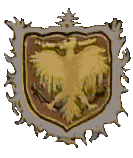
|
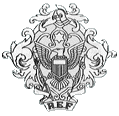
|
||
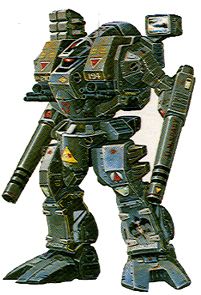
|
|||||
| Total Height: | 12.7 m |
| Height: | 11.3 m (ground to head unit) |
| Total Depth: | 5.1 m |
| Total Breadth: | 7.9 m |
| Weight: | 28 metric tons (dry) |
| 31 metric tons (fully loaded). |


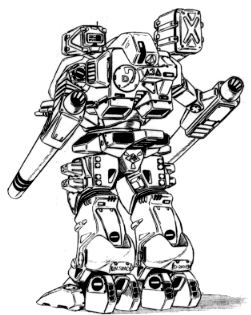
The armor on the Tomahawk (excepting the frontal torso) is composed of a standard Chobham laminar developed in the late 20th century and improved with the materials science advances made during the Robotech era. This armor was mainly designed to defeat projectiles and other kinetic weapons. The armor stops all small arms, heavy infantry weapons fire, and light mecha-mounted weaponry, and provides good to excellent resistance to medium mecha-mounted weaponry, such as the Valkyrie's 55mm APFSDS round, and poor to fair resistance to heavy mecha-mounted weaponry, such as the VHT's 120mm smoothbore shells.
The torso armor on the of the Tomahawk is composed of a standard Chobham laminar reinforced by a depleted Uranium mesh on the outer plate. More dense than the standard Chobham, this armor was designed to defeat projectiles striking the forward surfaces of main battle vehicles, and is also effective against beam weapons. The armor on the torso stops all small arms, heavy infantry weapons fire, and light mecha-mounted weaponry, and provides excellent resistance to medium mecha-mounted weaponry, such as the Valkyrie's 55mm APFSDS round, and fair resistance to heavy mecha-mounted weaponry, such as the VHT's 120mm smoothbore shells.
The Tomahawk provides full protection from nuclear, biological, and chemical hazards, using a sealed cockpit environment activated by radiation and hazardous chemical sensors, or manually when biological warfare conditions are anticipated. The internal consumables supplies can provide atmosphere for three days maximum.
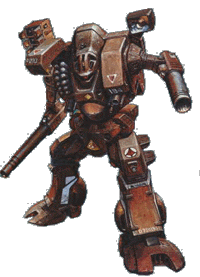
While the SDF-1 was being rebuilt, the militaries of the Earth set about to incorporate Robotechnology into their armies. It soon became clear that the well-established conventional tank/APC duet was no longer a completely satisfying military option. Thus, as a response to the mecha found on board the SDF-1, the Destroid series were developed, using an anthropomorphic design for true all-terrain capabilities. Because of the new technologies used, design and manufacture of each individual mecha unit was extremely expensive. Thus, when the specifications were drawn up for several of the new front-line mecha, attempts were made to retain a high degree of interoperability. In this vein, two classes of destroids which had to answer near identical demands on strength and mobility were specified to use a common leg section. The sections of these Destroids above the waist would however differ. Later, this leg section was used on board the SDF-1 as the basis for a third Destroid; this design was also produced on Earth after the Zentraedi Holocaust.
The leg assembly designed and built by Vickers-Chrysler, became the basis for a major Destroid series during the First Robotech War, the -04 series. Numerous versions of the -04 assembly saw combat service, the most important ones of these were the Mk. VI, a main battle robot, the Mk. X air defense variant and the Mk. XII mobile missile launcher. Other torsos, including a lighter main battle torso (the Mk. VII) and a combat engineering torso (Mk. VIII) were never ordered. A lighter and faster Destroid torso capable of "wearing" the Tomahawk's weapons jacket, the MBR-08 Mk. III 'Masamune' , saw only limited service in the RDF Marines.
The Tomahawk versions of the -04 series were heavily armed and armored weapon systems. Because of the limited understanding the UNDF had of the Tirolian technologies at that stage, the Tomahawk had to be equipped with a large arsenal of tried and powerful conventional weapons to back up the new, maintenance intensive, and somewhat mercurial, Robotech weapons. The latter were limited to two large particle beam cannons, derivatives of the Makral Tszikatro 05 mounted on top of the Zentraedi Glaug, and two light lasers in the two gun clusters. The armament was then augmented with a missile battery in the shoulders, with a light SAM missile battery in an external launcher, and further with two 25mm autocannon, two 180mm Petard mortars, two flame-throwers and two 12.7mm machine guns. The first production model (Mk. IV) mounted a larger cockpit hood and sensor array in place of the machine guns and AA missiles, but all these were later refitted into the final Mk. VI configuration. The Tomahawk Mk. IV first walked off the assembly lines in February of 2007. In addition to the Mk. IV, there was another main battle version, the MBR-04 Mk. V Warhawk, which replaced the detachable weapons pack with the set used on the Marines' MBR-8 Mk. II Masamune. As this configuration was predicted to be rather similar to the Spartan in combat performance, very few of the Mk. V Warhawks were ever produced, and these were later refitted into the Mk. VI Tomahawk standard.
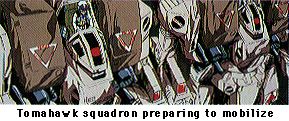
By early 2009 the Mk. VI, the ultimate version of the Tomahawk line, had begun to be produced en masse and started to replace its earlier brethren, serving with the RDF Army and Marines, and with the Southern Cross' Tactical Corps in its first decade of existence. The Mk VI's weapon load would give the Tomahawk an excellent capacity either to fight the aliens, or to keep order in the world. Because of the numerous barrels (12 in total) projecting from the front, the Tomahawk was a feared sight among the populace. As a premier combat mecha, the Tomahawk saw much action in the various battles with the Zentraedi. Typically, it would be the first front-line mecha to engage, using its missiles to suppress air attacks and Missile Pods, then opening up on approaching Pods with its heavy particle beams. As the range closed the TZ-III gun clusters would be brought into play. Generally, this would break up any but the most determined of attacks.
Return to UNDF Mecha Index
Go to Robotech Reference Guide Home Page.
Robotech (R) is the property of Harmony Gold. This document is in no way intended to infringe upon their rights.
Content by Pieter Thomassen and Peter Walker, with Rob Morgenstern